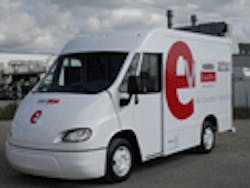Total ownership cost key to electric truck appeal
As more light- and medium-duty all-electric truck models are rolled out for commercial fleets, a new report indicates the future success of such vehicles hinges on their ability to deliver lower total cost of ownership (TCO) then their gasoline- and diesel-powered brethren.
“We’re bullish on electric trucks in the mild delivery segment because of their competitiveness on a TCO basis,” Sam Jaffe, research manager for consulting firm IDC Energy, told Fleet Owner. “Passenger car buyers tend not to make purchases based on TCO. Commercial fleet owners do.”
According to IDC’s latest report – The Coming Electric Vehicle Rollout: Forecasting the Market – even with depreciation of the pricey battery packs required to power electric vehicles (EVs), they are still typically more cost-effective on a TCO basis compared to petroleum-powered vehicles.
Jaffe said it costs 10 to 13 cents to push a gasoline-powered car one mile at current prices, but costs somewhere between 2 and 5 cents to do the same with an EV. “Add in the depreciation of the battery and you’re at about 7 to 10 cents [per mile],” he said. “Those fuel savings add up over time and make the EV a cheaper option.”
The high cost of batteries, however, remains a challenge. “Today, a lithium ion battery pack probably costs about $1,000 per kilowatt-hour (kWh). We expect that to be reduced to $400 by 2013, but the cost of an unsubsidized battery pack today is prohibitive.”
Yet it’s the overall TCO figures that will drive EV demand: so much so that IDC predicts that over 885,000 plug-in electric vehicles (PEVs) will be sold in North America by 2015, with almost 800,000 units being sold in Europe and 2.7 million worldwide within the next four years as well.
Jaffe added PEV penetration rates could reach as much as 4% of the global automotive fleet by 2020, but that even within this aggressive scenario, the overall impact on utility revenue and electricity demand will be relatively limited, with PEVs consuming approximately the same amount of electricity as electric clothes dryers do.
“PEVs are coming,” he noted. “Despite many doubters, this oft-promised technology is finally on the verge of becoming a reality, with more than 540,000 [PEVs] to be sold globally by 2012. The electric utilities industry [which would supply power to PEVs] does not have the luxury of taking a wait-and-see approach: it must begin to prepare for their arrival now.”
Truck OEMs are gearing up to take advantage of projected EV demand, too, introducing a bevy of new all-electric truck models to the fleet market.
Freightliner Custom Chassis Corp. (FCCC) recently unveiled its new MT-EV all-electric walk-in van (WIV) at the 2010 Hybrid Truck Users Forum (HTUF) this week, equipped with a unique aerodynamic body from Morgan Olson. The truck is powered by Enova Systems’ 120 kilowatt (kW) all-electric drive technology and Tesla Motors’ lithium-ion batteries.
FCCC believes its MT-EV offers a three- to four-year payback based on fuel savings and believes this chassis will be particularly appealing to parcel delivery fleets such as UPS and FedEx.
Mitsubishi Fuso recently showed off an all-electric concept van based on its popular Canter truck at the recent IAA Commercial Vehicles show in Hannover, Germany. The Canter is typically sold as a Class 3 diesel or hybrid vehicle in the U.S. and around the world, Mitsubishi said, and the all-electric version would provide a range of about 75 mi. With a gross vehicle weight of 3.5 tons, the Canter E-Cell can achieve speeds of almost 50 mph, the company noted.
“A year ago it felt like we were trying to pull the market forward. Now we have our customers pushing us,” Bryan Hansel, CEO of Smith Electric Vehicles U.S., told Fleet Owner. Smith builds the Newton delivery truck, which offers a range of 50 to 120 mi. and a top speed of 50 mph.
“I think the biggest reason is because awareness is growing and our customers understand the price savings inherent in switching from diesel to electric,” he said. “The lesson from these tough economic times is that businesses are looking at alternative ways of cutting costs without cutting production.”
While IDC’s Jaffe believes there’s plenty of electricity generation capacity to power significant numbers of commercial and consumer EVs and PEVs, the tricky problem will be managing spikes in demand that occur when such vehicles are recharged.
“We are not concerned about the ability to meet the electricity demand of PEVs: there is plenty of excess generation capacity,” he explained. “We are concerned, however, with the potential damage that clustering of PEVs can have on distribution equipment. If three PEVs on the same cul-de-sac start charging at the same time, it could blow the step-down transformer – that's a $20,000 repair job. Utilities must anticipate where clustering will occur and renovate certain parts of the distribution system in those areas before they [EVs] arrive in big numbers.”
About the Author
Sean Kilcarr
Editor in Chief
Sean Kilcarr is a former longtime FleetOwner senior editor who wrote for the publication from 2000 to 2018. He served as editor-in-chief from 2017 to 2018.
